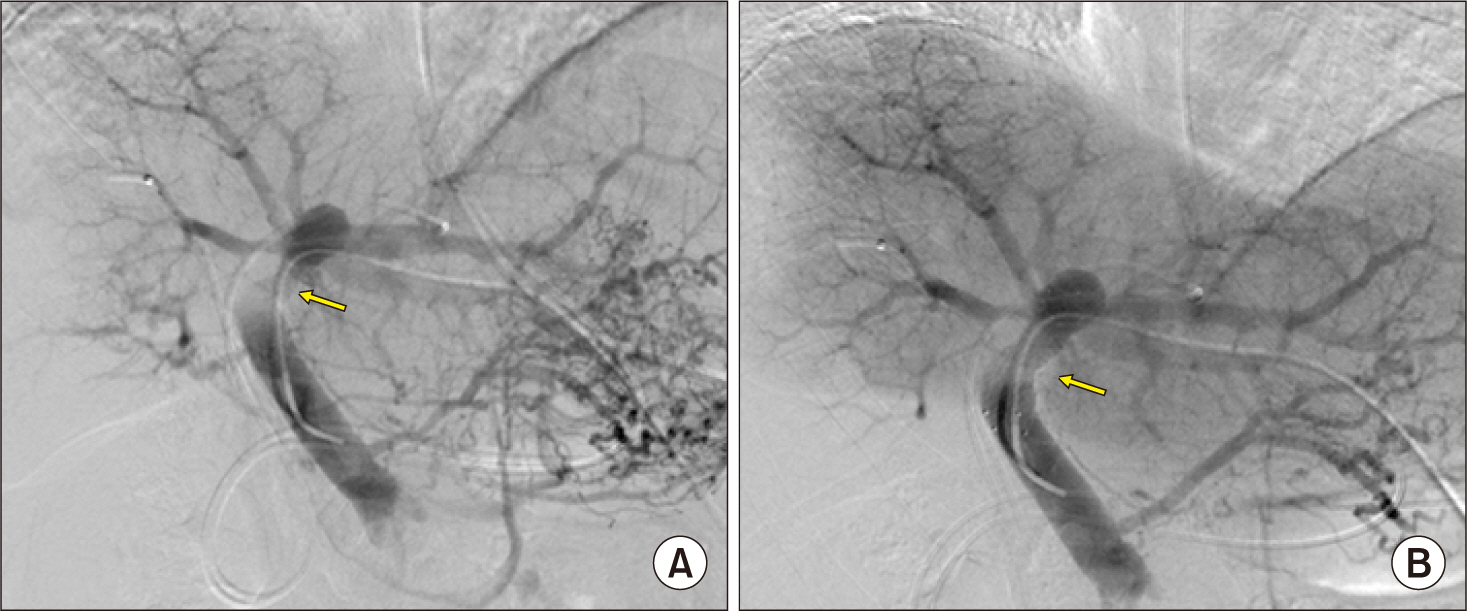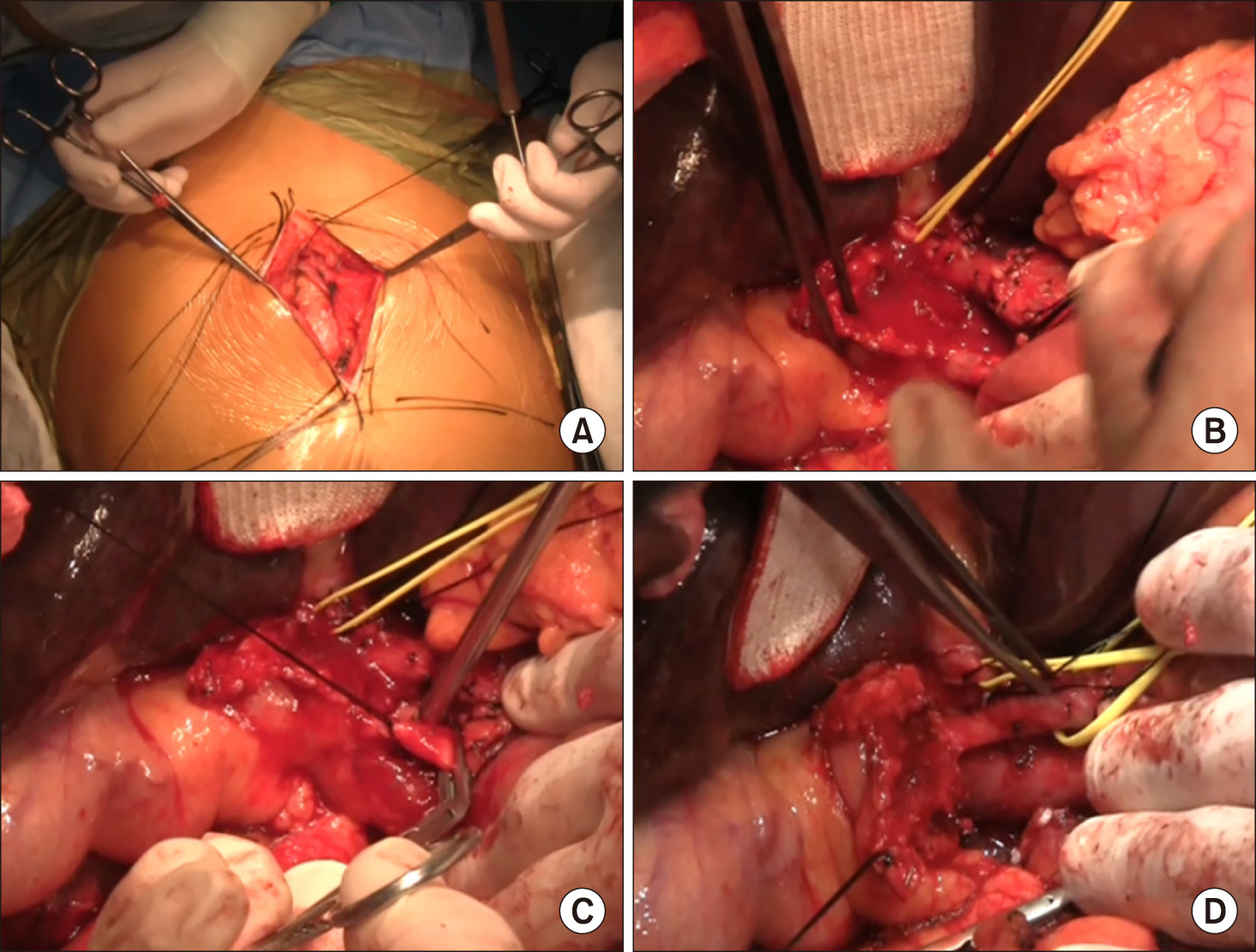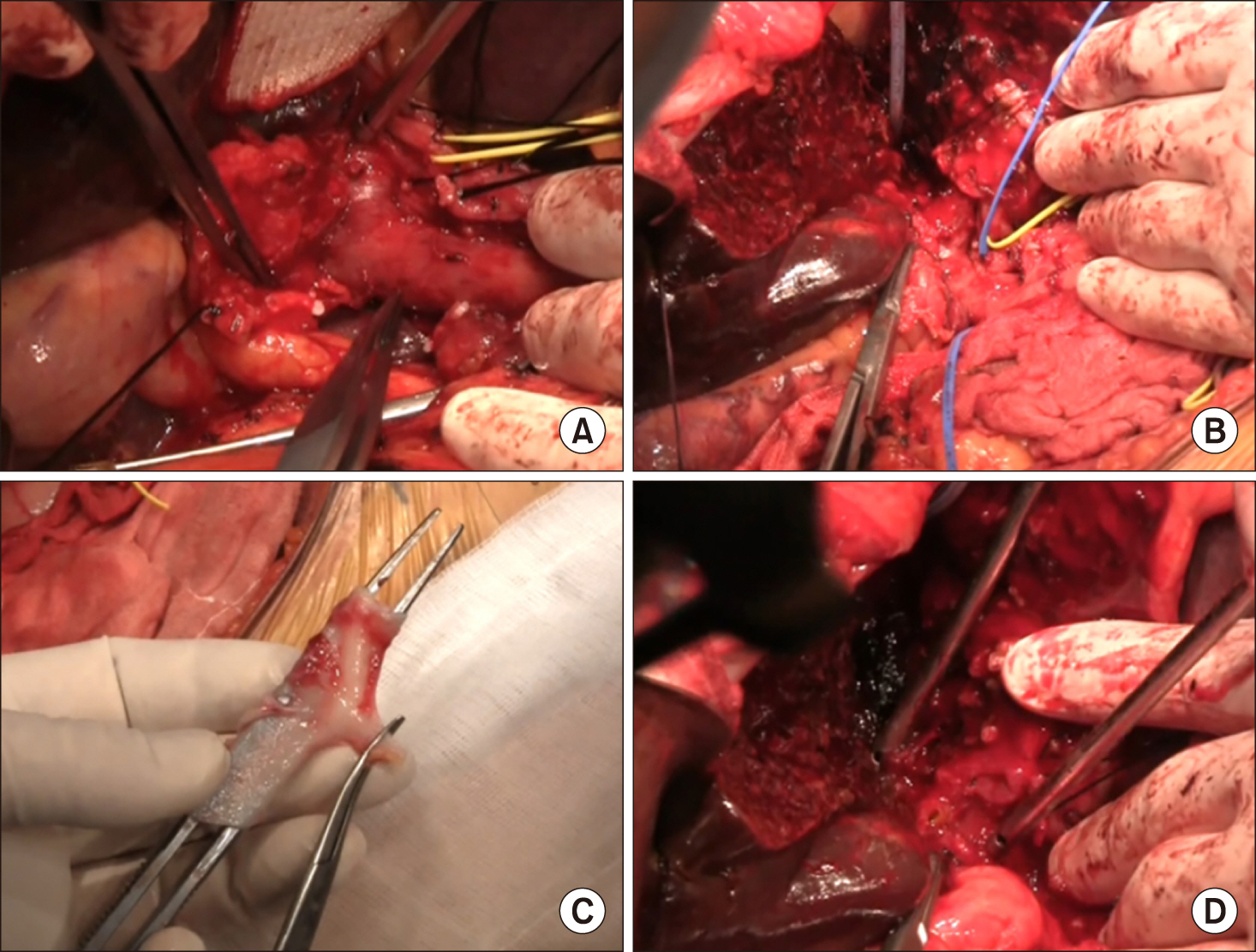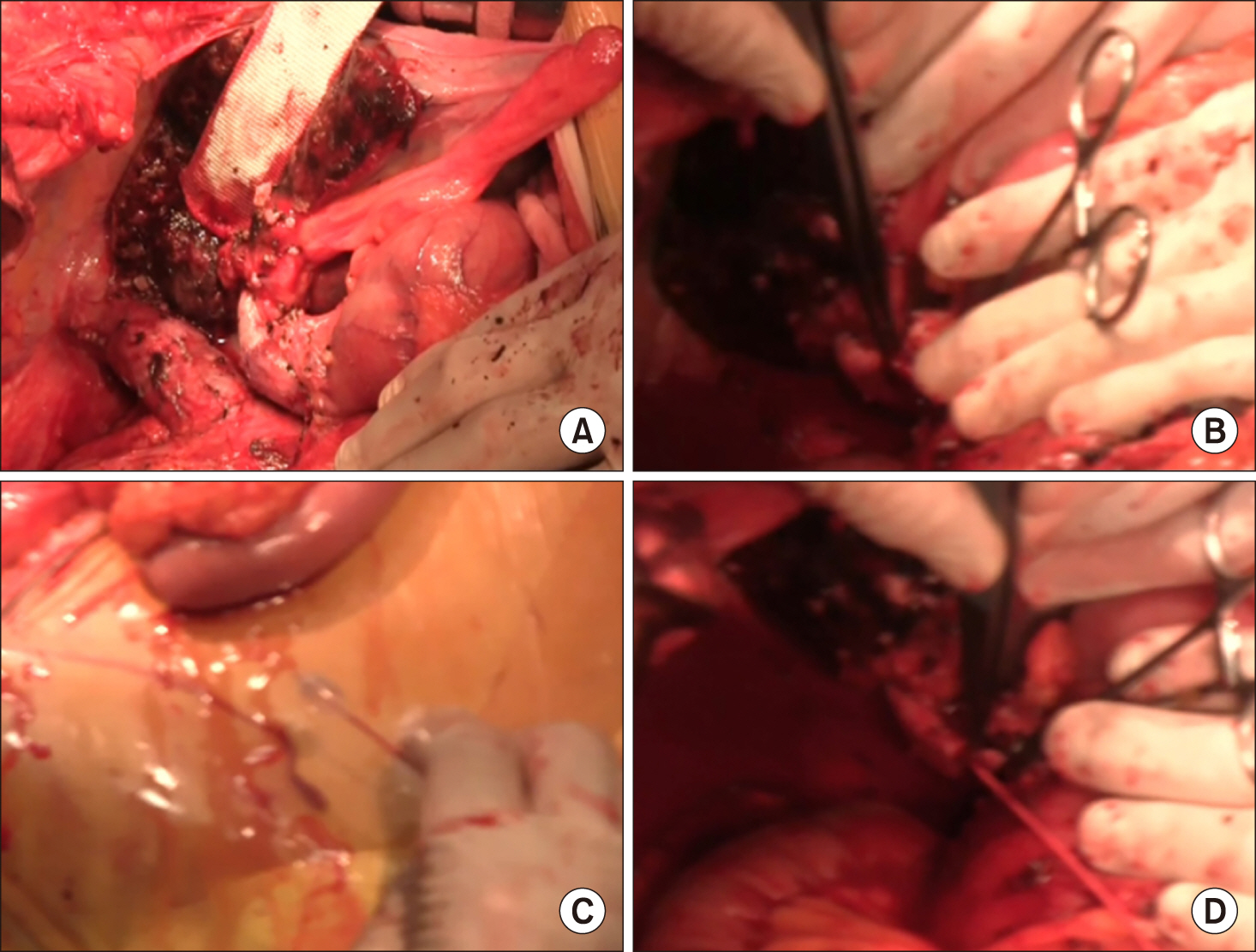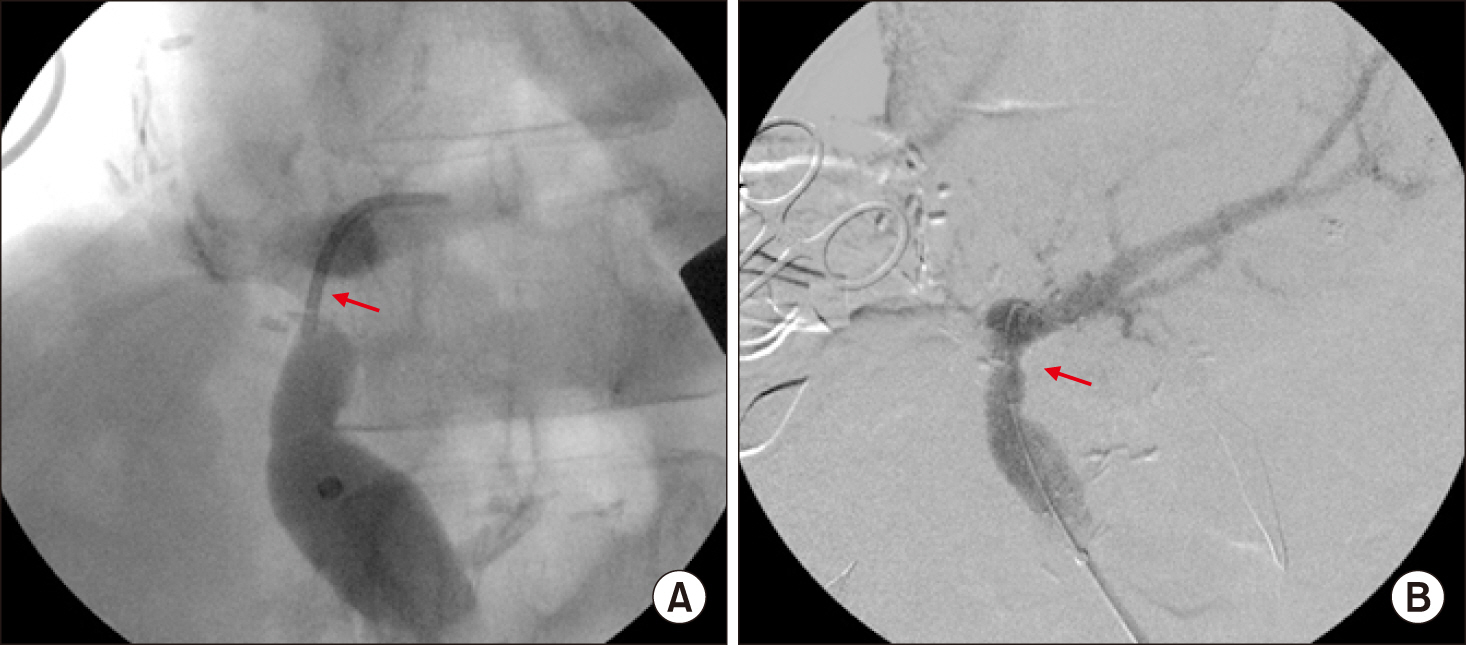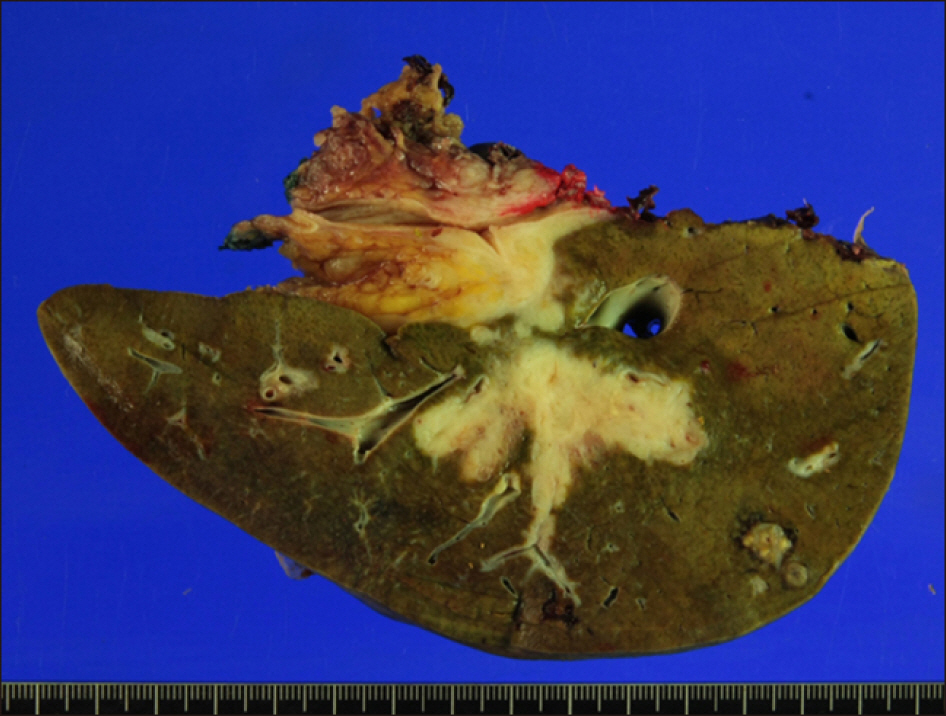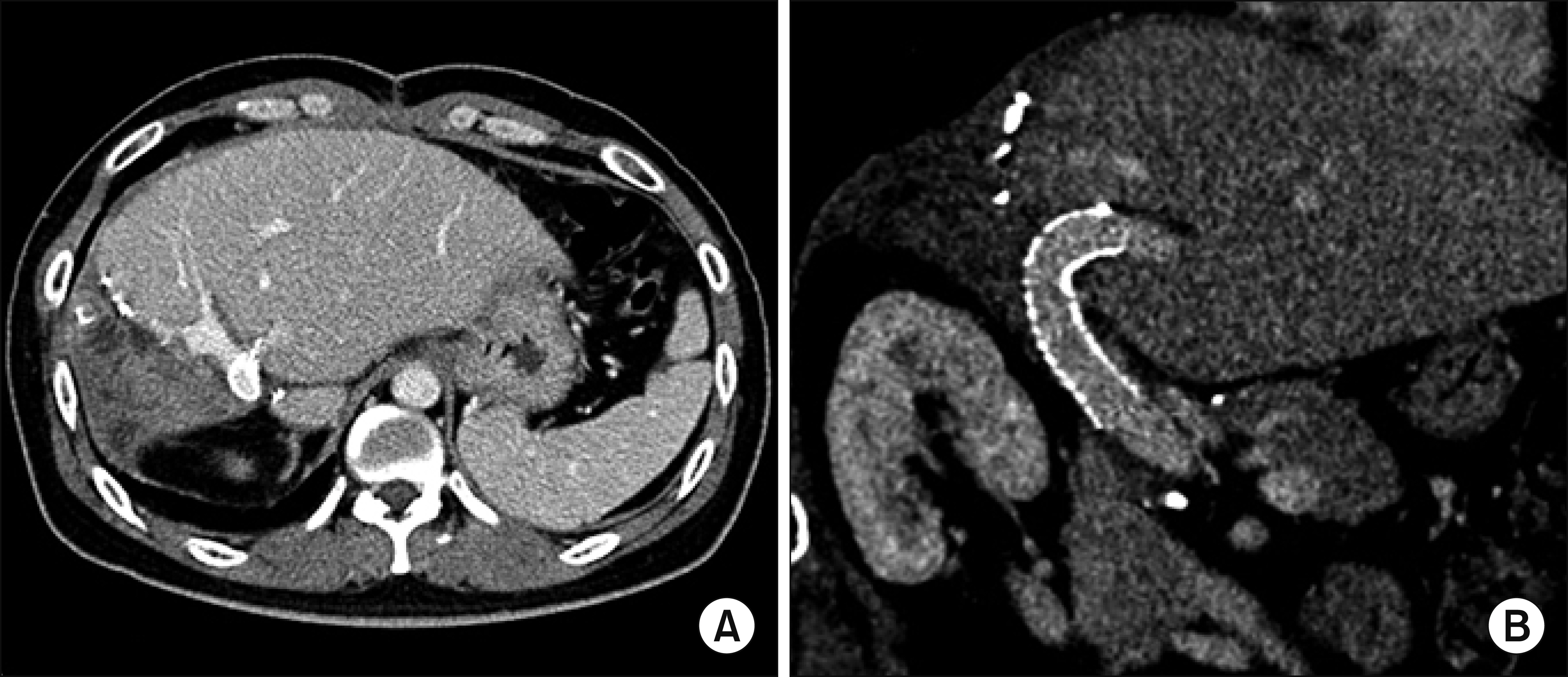Ann Hepatobiliary Pancreat Surg.
2020 May;24(2):174-181. 10.14701/ahbps.2020.24.2.174.
Right trisectionectomy with en bloc portal vein resection for cholangiocarcinoma after preoperative stenting for main portal vein occlusion
- Affiliations
-
- 1Departments of Surgery, Asan Medical Center, University of Ulsan College of Medicine, Seoul, Korea
- 2Departments of Radiology, Asan Medical Center, University of Ulsan College of Medicine, Seoul, Korea
- KMID: 2500802
- DOI: http://doi.org/10.14701/ahbps.2020.24.2.174
Abstract
- Deprivation of portal blood flow decreases the hepatic function, thus hepatobiliary cancer patients with total occlusion of the main portal vein (PV) are usually not indicated for major hepatectomy. We herein present a 37-year-old male patient with advanced intrahepatic cholangiocarcinoma, in whom right trisectionectomy was indicated. However, the main PV was nearly completely occluded by tumor invasion, thus resolution of jaundice was markedly slow. To restore the liver function through PV recanalization, a wall stent was inserted percutaneously. Jaundice resolved progressively after PV stenting. Right trisectionectomy, caudate lobectomy, bile duct resection, and en bloc PV segmental resection with iliac vein homograft interposition were performed. However, PV thrombosis developed at the site of PV stent removal, thus a new wall stent was inserted during the operation. The pathology report presented that the tumor was a 5.2 cm-sized well-differentiated adenocarcinoma of periductal infiltrating type with lymph node metastasis. During the follow-up, the interposed PV segment with a wall stent was gradually occluded with development of portal collaterals. At 5 years after surgery, the PV stent was completely occluded and collaterals developed. The patient experienced repetition of febrile episodes of unknown causes. He is currently alive for 8 years with no evidence of tumor recurrence. The detailed surgical procedures were presented with a supplementary video clip of 5 minutes.
Figure
Cited by 2 articles
-
Hilar portal vein wedge resection and patch venoplasty in patients undergoing bile duct resection for hepatobiliary malignancy: A report of two cases
Sung-Min Kim, Shin Hwang
Ann Hepatobiliary Pancreat Surg. 2021;25(1):132-138. doi: 10.14701/ahbps.2021.25.1.132.Portal vein wedge resection and patch venoplasty using autologous and homologous vein grafts during surgery for hepatobiliary malignancies
Byeong-Gon Na, Shin Hwang, Dong-Hwan Jung, Sung-Gyu Lee
Ann Hepatobiliary Pancreat Surg. 2021;25(4):509-516. doi: 10.14701/ahbps.2021.25.4.509.
Reference
-
1. Kaneoka Y, Yamaguchi A, Isogai M, Hori A. 1998; Intraportal stent placement combined with right portal vein embolization against advanced gallbladder carcinoma. Surg Today. 28:862–865. DOI: 10.1007/s005950050243. PMID: 9719013.2. Hyodo R, Suzuki K, Ebata T, Komada T, Mori Y, Yokoyama Y, et al. 2015; Assessment of percutaneous transhepatic portal vein embolization with portal vein stenting for perihilar cholangiocarcinoma with severe portal vein stenosis. J Hepatobiliary Pancreat Sci. 22:310–315. DOI: 10.1002/jhbp.200. PMID: 25546292.
Article3. Novellas S, Denys A, Bize P, Brunner P, Motamedi JP, Gugenheim J, et al . 2009; Palliative portal vein stent placement in malignant and symptomatic extrinsic portal vein stenosis or occlusion. Cardiovasc Intervent Radiol. 32:462–470. DOI: 10.1007/s00270-008-9455-9. PMID: 18956224.
Article4. Woodrum DA, Bjarnason H, Andrews JC. 2009; Portal vein venoplasty and stent placement in the nontransplant population. J Vasc Interv Radiol. 20:593–599. DOI: 10.1016/j.jvir.2009.02.010. PMID: 19339200.
Article5. Yamakado K, Nakatsuka A, Tanaka N, Fujii A, Terada N, Takeda K. 2001; Malignant portal venous obstructions treated by stent placement: significant factors affecting patency. J Vasc Interv Radiol. 12:1407–1415. DOI: 10.1016/S1051-0443(07)61699-6. PMID: 11742015.
Article6. Zhou ZQ, Lee JH, Song KB, Hwang JW, Kim SC, Lee YJ, et al. 2014; Clinical usefulness of portal venous stent in hepatobiliary pancreatic cancers. ANZ J Surg. 84:346–352. DOI: 10.1111/ans.12046. PMID: 23421858.
Article7. Ko GY, Sung KB, Yoon HK, Lee S. 2007; Early posttransplantation portal vein stenosis following living donor liver transplantation: percutaneous transhepatic primary stent placement. Liver Transpl. 13:530–536. DOI: 10.1002/lt.21068. PMID: 17394150.
Article8. Kim YJ, Ko GY, Yoon HK, Shin JH, Ko HK, Sung KB. 2007; Intraoperative stent placement in the portal vein during or after liver transplantation. Liver Transpl. 13:1145–1152. DOI: 10.1002/lt.21076. PMID: 17663391.
Article9. Ohm JY, Ko GY, Sung KB, Gwon DI, Ko HK. 2017; Safety and efficacy of transhepatic and transsplenic access for endovascular management of portal vein complications after liver transplantation. Liver Transpl. 23:1133–1142. DOI: 10.1002/lt.24737. PMID: 28152572.
Article10. Hwang S, Sung KB, Park YH, Jung DH, Lee SG. 2007; Portal vein stenting for portal hypertension caused by local recurrence after pancreatoduodenectomy for periampullary cancer. J Gastrointest Surg. 11:333–337. DOI: 10.1007/s11605-006-0058-y. PMID: 17458607.
Article
- Full Text Links
- Actions
-
Cited
- CITED
-
- Close
- Share
- Similar articles
-
- Right trisectionectomy with en bloc portal vein resection for perihilar cholangiocarcinoma after preoperative left portal vein stenting and sequential right portal and hepatic vein embolization
- Portal Vein Occlusion after Biliary Metal Stent Placement in Hilar Cholangiocarcinoma
- Anatomical variation of the Main and Right Portal Vein on Indirect Portogram: Correlated with CT and Hepatic Angiogram
- Blood flow volume difference (P-SS) between the portal vein and thesum of splenic vein and superior mesenteric vein in portal hypertension
- Noncancerous Right Portal Vein Occlusion: 2 cases


